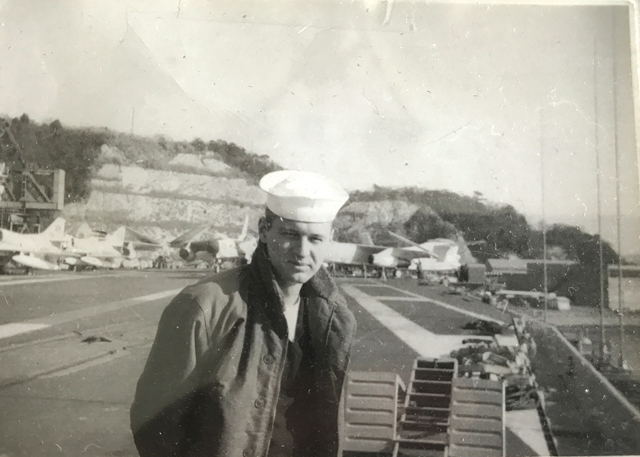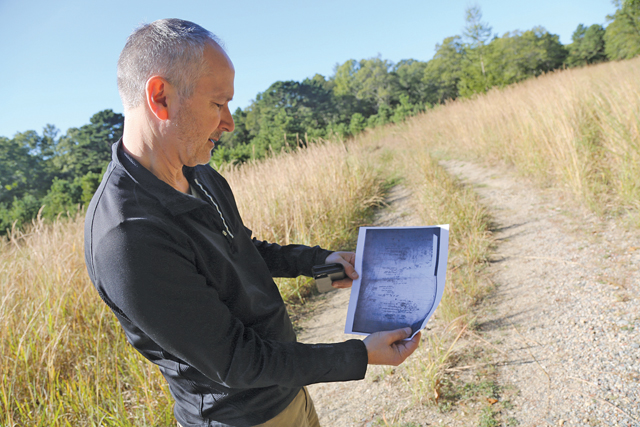Over 50 years after Calverton plane crash, a son searches for answers

On Feb. 6, 1964, a C-54 Navy cargo plane carrying aircraft equipment and eight men set off from Kirtland Air Force base in New Mexico, headed for the East Coast.
That night, just before 8 p.m., the plane approached what was then the Peconic River Airport in Calverton, in a rain driven by gusty winds, and crashed into a wooded area just south of Route 25, not far from the runway, according to an article in The New York Times the next day.
Six of the passengers were killed in the crash, including aviation mechanic Norman Seitz. Fifty-three years later, Mr. Seitz’s son Jim has been searching for answers about the crash, including its exact location.
Last week, Mr. Seitz, an English professor at the University of Virginia in Charlottesville, came to Calverton on his second attempt to find the site. He visited the area for a day about a year ago, but had limited and conflicting information on where the plane went down. This time, after searching two days with a better handle on the location, he had a breakthrough. He found the crash site.
“It’s been this thing where I thought coming here would be depressing,” Mr. Seitz said last Wednesday, a few hours before discovering what he believed to be some of the wreckage. He was walking down a dirt path behind the Stony Brook Incubator building in Calverton, surrounded by tall grass and brush. He squinted his eyes in the afternoon sunlight.
“Instead it was the opposite,” he continued. “I actually felt kind of elated. I think it was that there was a lot of mystery for me surrounding my father’s death because I was so young and they didn’t let me go to the funeral and we never talked about it at home. I had all these questions all my life about it.”
While Mr. Seitz, now 59, was only 5 years old when his father died, he remembers bits and pieces about him. It wasn’t until he was a teen that his mother showed him an article about the accident from the Albuquerque Journal, where they were living then, and some items that belonged to his father.
He recalled finding it strange to realize that his father’s death wasn’t just a personal story, but also one with a historical side. The crash appeared in newspapers and his family received a letter of condolence from President Lyndon B. Johnson.
But learning more about what happened that night in 1964 wasn’t always Mr. Seitz’s mission. For a while, although he’d think about his father each year around the anniversary of his death, he had his questions about the crash in the back of his head. While pursuing a graduate degree at New York University, a boyfriend of his mother’s suggested he drive out east to the crash site.
“And I was like, ‘Why would I wanna do that?’” he recalled. “That seems like just a recipe for depression. He died in the crash; why would I want to go see where it happened? That was back in my twenties and I had no interest in it whatsoever.”

Things changed years later, when Mr. Seitz decided to write a book about his father. It led him to memories that helped bring about connections to his father. The book, on which he is still working, is the story of his search for a father he partly knew, but partly didn’t because he was so young when he died.
“I ended up doing all these things because I do remember him,” he said. “I remember he had a naval tattoo on his arm. I went and got a tattoo of a Navy anchor on my arm. I remember that he drove a motorcycle. I went and got a motorcycle and learned how to ride.”
And then he got interested: What happened that night?
Mr. Seitz remembered that his mother told him his father was worried about the flight the night before departing. There was too much weight on the plane, he said.
He filed a Freedom of Information Act request for the Navy’s accident report, which was waiting in his mailbox when he returned from searching in the general location of the crash for the first time. He had been looking in the wrong area.
Last week, Riverhead Town historian Georgette Case gave him an article from the Sunday Review that had more specifics on the accident. That, along with the first-hand account of a passerby who saw the plane go down and rescued two survivors that appeared in both the article and accident report, helped him get closer.
“I had never had the information given that clearly, and so yesterday I was wandering out in the woods, where I wasn’t supposed be, I’m sure, scared up a lot of deer,” Mr. Seitz said last Wednesday before he located the site. “I think I was too far south of where it actually happened.”
The report describes the site’s location as a thousand feet from Route 25. It mentions a dirt road that the witness, Alfred Douglas of Centereach, ran down after scaling a 10-foot fence topped with barbed wire, as well as a small pond he passed on the way.
Mr. Seitz went left at a fork in the dirt path. He saw the pond. He compared the accident report’s map with Google maps. He shielded his eyes as he looked out across a clearing off the dirt path.
It’s possible a whole forest could have grown over the crash site in the last 53 years, he said. He decided to walk 1,000 feet back up the path, to gauge whether he was any closer.
The next day he sent the News-Review an email. A few more hours of searching led him to a different dirt road, closer to Route 25, that runs along the pond, he said. He saw a pit where it looked like crews may have dug around the wreckage.
Sure enough, he wrote, “I came across pieces of the plane half-buried in the ground in several locations.”
When asked how he felt in that moment, he sent this:
“My feelings were all over the place. On the one hand, it was kind of creepy, like something out of a horror film, to find these pieces of wreckage poking up from the ground, like remnants of a battlefield from long ago. Though I’d imagined potentially finding something the cleanup crew had left behind, I never figured I’d encounter so many shards of the plane spread across the woods. I didn’t even have much time to look — it was getting dark — but I came across over twenty fragments of various kinds, some no bigger than my hand, others rather bulky and heavy.
“On the other hand, it felt good to finally have some of my questions answered, even if there’s much that will always remain a mystery. I stood there in the woods at the place where I’m pretty sure my father’s body was found, and I told him — perhaps the him inside me — that I’ll always miss him.”
Top photo: Jim Seitz used an accident report in his attempt to find the crash site last Wednesday. (Credit: Kelly Zegers)








